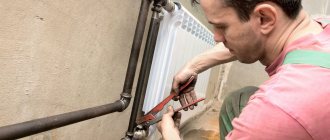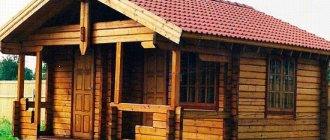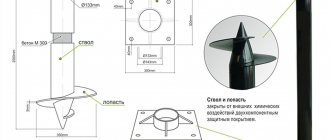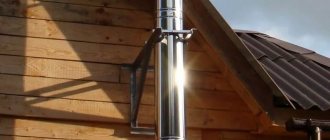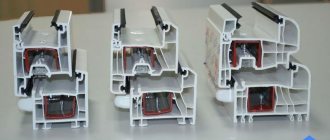The presence of an autonomous sewer system in a country house is one of the mandatory requirements that potential owners place on them. And this is correct - few people want to jump outside for natural needs when the temperature drops below -20...-30 degrees, and stays at this level for weeks. Therefore, many modern country houses have all the benefits of civilization. But many people have a completely reasonable question: “Will sewerage cause problems in winter?” It will be very useful to study this issue in as much detail as possible.
Operating a septic tank in winter
If the system works permanently, then there is nothing to be afraid of. Septic tanks operating in winter do not require additional heating or any special conditions. The fact is that constant drainage of wastewater at room temperature will prevent the system from freezing. The most important thing is not to open the lid in extreme cold, otherwise the liquid may freeze. The lid itself is already insulated and fits hermetically to the tank. There is no need to insulate it, since biomass, when decomposing, releases additional heat. In addition, the compressor operates permanently.
How will the septic tank work in winter if you come to the dacha only on weekends? Isn't it better to turn it off? No, because bacteria will only multiply with constant aeration (bubbling). To save money, you can install a special relay that periodically turns off the power. However, even systems for families of four to five people are not particularly expensive in terms of electricity.
How to prevent sewer pipes from freezing
If you want to prevent your sewer pipes from freezing, use these tips:
- Install the pipes at the correct angle. The optimal option is 2 cm in height per 1 m of length. If the slope is minimal, the runoff will stagnate and freeze. If the slope is large, deposits will accumulate, which will reduce the useful diameter of the pipe.
- How to insulate a septic tank for the winter? Use foam-based polyethylene for insulation.
- Organize water drainage from the septic tank in winter using a pump. Water flows by gravity at low speed. The pump compartment will accumulate mass, and the device will fill it with energy.
- Use products that dissolve fats more often. This will prevent the accumulation of fats, which will cause stagnation of water and freezing of the septic tank.
It is useful to know how to prevent a septic tank made from freezing from freezing. To prevent this, it is advisable to regularly inspect the system and also consider reliable insulation.
Preservation of the septic tank
What to do with a septic tank in winter if you are not going to live in a country house during the cold season? It must be preserved without fail. The main disadvantage of preservation is that the spontaneous generation of bacteria in the spring will take from one to two weeks. Preservation instructions are included with each installation. The whole job will take you about an hour or two. If you don’t want to do it yourself, you can call specialists.
We list all the stages of conservation of volatile systems:
- disconnection from power supply. All biological treatment stations are energy dependent. They are turned off using a remote control or switches in the house. In some stations, you must first turn it off using a key located on the control unit of the installation.
- cleaning the system chambers from sludge.
- Removing the compressor.
- removing the pump. After this, the product is inspected, cleaned and repaired if necessary.
- checking the fluid level. If there is less water, add clean water so that each chamber contains 2/3 of the total volume.
- install floats. If you live in a place with harsh winters. They are placed so that the pressure on the walls of the tank is reduced, and the resulting ice does not break the body of the installation. To do this, use ordinary plastic bottles of 1.5, 2 or 5 liters. Fill them (about a third or half) with sand and lower them into the tank so that the top of the bottles is held vertically on the surface. The caps are not screwed on completely. A rope is tied to the necks of the bottles to make them easier to get when re-opening begins.
- insulate the station cover. This is done using penoplex foam 5 cm thick. Usually four sheets are needed. The walls and cover of the station's insulating box are assembled from foam sheets. To prevent the penoplex from getting wet and preserve its properties, the finished box is covered with plastic film and pressed down around the perimeter with stones.
What are the dangers of a freezing septic tank?
If the septic tank freezes in winter, this can cause adverse consequences. They will be discussed in more detail below.
Hull damage
To fix the problem, you need to dismantle it and then install new equipment.
To prevent damage, do not purchase cheap or used materials. Consider how resistant they are to frost. If the stability is high, the material will last for decades.
Settlers, which are energy independent, are made from low-density polyethylene. Aeration stations with complex operation are made from high-quality polypropylene. Low pressure polypropylene acquires a glassy state at a temperature of -50°C.
Ordinary polypropylene changes structure at -5°C. At a temperature of -55°C, polypropylene changes its chemical properties, which is produced according to the principle of copolymerization with frost-resistant agents.
Damage to equipment inside the septic tank
Often, due to freezing of the septic tank, the pump, control unit, compressor and sockets are damaged.
Because of this, you will have to spend money on maintenance and repair work. To fix the problem, you need to replace or repair the equipment.
As a preventative measure, winter canning is carried out.
This is done according to this principle:
- the electrics turn off;
- the compressor is removed;
- plastic bottles with sand are installed - this helps prevent damage to the internal partitions;
- install additional insulation on top and sides with your own hands.
Reduced quality of cleaning at water temperatures below +10 °C
In this case, you need to insulate the upper part, and also increase the flow of hot water.
Systems in which the compressor supplies hot air from the room using an insulated hose do not suffer from this problem.
Before you buy a budget septic tank, think about safety. To do this, use these tips:
- Install the septic tank on the north side of the site behind the wall of the house. This way it will not be damaged by ultraviolet radiation and severe frosts.
- Insulate the upper part, which is located 40 cm from the surface of the earth. It is advisable to use expanded clay or polystyrene foam. It is better to avoid using mineral wool.
- Do not install insulation in a septic tank below 1.5 m from the ground surface. In such areas, the temperature is high, and the soil transfers geothermal heat to the septic tank. This will minimize damage.
- Do not apply insulation to walls. Otherwise, buoyancy will increase, which will lead to floating in the spring.
- Do not clear snow from the septic tank. It can be an excellent insulator.
- Inspect the fixtures inside the house to ensure they are in good working order. If the cistern is faulty, cold water will leak into the system. This will provoke suspended animation of the bacteria, and they will stop producing heat.
Does the septic tank freeze in winter?
Yes, if it was not properly preserved for the winter. Also, the septic tank can freeze in winter if errors were made during installation. This mainly concerns not so much the septic tank itself, but the pipeline. Let's analyze the main errors during installation and operation:
- the pipeline is not laid deep enough, above the freezing point of the soil. At the same time, the highway is poorly insulated.
- During installation, a pipe of smaller diameter or low slope was used. The error led to stagnation of flows, and the water in a certain area froze.
- Fat deposits inside the pipeline do not allow drains to pass freely.
- there are no inflows of warm liquid into the pipeline. For example, due to a malfunction, only cold water flows into the main line.
- the system is located far from a residential building.
If it is not possible to bury the septic tank
Alas, in some cases, dacha owners simply do not have the opportunity to install a septic tank below the freezing depth of the soil. In this case, insulation should be approached much more seriously - this is no longer a precaution, but a necessity.
The septic tank should be insulated when installing it. Expanded clay or foam chips should be used as thermal insulation materials - low cost combined with good thermal insulation make these materials the optimal solution to the problem.
Some attention should be paid to the thermal insulation of pipes leading to the septic tank. It is best to use polymer pipes - they do not rust, are light in weight and are relatively inexpensive, for which they are highly valued by specialists. The pipes must be wrapped with a suitable thermal insulation material, and then placed in a shell of asbestos-cement pipe, which protects against any mechanical damage.
Insulation of sewer pipes
When laying pipes, special attention should be paid to the slope. The minimum slope should be 2 degrees, that is, 2 cm of slope per 1 meter of pipe. However, in practice, experts prefer a slope of 5-7 degrees, which ensures rapid passage of water along with the contents through the pipes. But you shouldn’t get too carried away - it’s better that the slope falls in the range from 2 to 7 degrees.
If the pipes are laid at a lower slope, there is a danger that water will not move through them. If the slope is too large, water flows through very quickly, but solid waste can linger in the pipe, accumulating and clogging it. Of course, when laying, you should avoid using corners and turns - they significantly increase the risk of blockages. When installing a sewerage system for a one-story house, pipes with a diameter of 50 mm are suitable. If we are talking about a two-story house, on the upper floors of which there are sinks, a toilet and a bath, then pipes with a diameter of 200 mm are better suited.
What to do if the system is frozen?
There are several ways to defrost a drain.
- pouring boiling water. Using a rubber hose inserted into the pipe and a funnel, boiling water is poured. The hose should rest against the ice plug. When the plug melts, the hose is pushed through the pipeline to completely dissolve the ice.
- flushing with saline solution. Having heated the water to 70 degrees using the boiler, open the tap and drain the water into the bathroom. Pre-dissolve salt in it (1:10). We wait half an hour. If the ice plug has not thawed during this time, you should use the following method.
- heating the pipe. Using a construction or household hair dryer, heat the section of the pipe that goes outside.
- caustic soda. This method should help if the traffic jam does not form near the house, but closer to the system. Mix caustic soda (3 kg), hot water (6 l), boiling water (1 l). Pour the mixture down the drain. The large amount of heat from the chemical reaction should melt the cork. This will be noticeable if the mixture begins to flow freely into the drain. You should work in a respirator, gloves and goggles.
- heating the pipe with excavation of the route. If none of the previous methods gave results, then you should use this method. To determine where the plug formed, we dig a trench. Next, using a mallet, tapping the pipe, we find out the location of the ice. The area with the congestion is heated with a hair dryer.
If the septic tank is already frozen, then you can use the following methods to defrost it:
- — Watering the sewer and septic tank with hot water. Hot water will defrost the ice if it has not yet become very thick.
- — You can make a special reagent at home from salt and baking soda. It is necessary to make such a solution highly concentrated so that the sewer system can be cleaned from the inside. This is the most effective and cheapest method of defrosting a septic tank.
- — Application of heating cables. This requires special devices and heating cables. These cables are wrapped around the perimeter of the septic tank and heated until the ice completely melts. However, this is a rather expensive method, the use of which also requires certain professional skills.
To avoid problems with the operation of the septic tank, it is necessary to use insulating agents at the design stage and then during installation, as well as maintain the correct installation depth. If it is not possible to carry out the installation work yourself, then it is best to contact a specialized company.
Installing the system in winter
We already know that the system can be successfully operated throughout the cold period. The next advantage is that the septic tank can even be installed in winter. Let's look at the installation algorithm step by step:
- First of all, the area for the foundation pit is cleared of snow.
- Mark the dimensions of the pit on the ground and begin digging.
- drill a hole in the tank for the sewer pipe. Next, insert the pipe into the hole and seal it.
- drill a hole to drain purified water.
- At the bottom of the dug pit, a sand base is made.
- The tank is carefully lowered into the pit so that the lid is above ground level. Next, level the system, cover the edges with sand, and pour water inside.
- An alarm is mounted on the tank lid.
- A pipe is inserted into the hole intended for the water drainage pipe and sealed.
- digging a trench to the house.
- assemble and install a pump that will discharge purified water.
- a sewer pipe is inserted into the system. The trench is filled with sand.
- An electrical cable is connected to the system.
- compressors are connected.
- install a pipe that will drain purified water.
Advantages of structural design at subzero temperatures
The advantages of installation in winter are as follows:
- low level of groundwater, which guarantees the absence of water in the developed pit. This is especially important in areas with elevated levels of underground sources and in the presence of open water bodies near them;
- gardening and gardening activities are not carried out, which causes the absence of people at the dacha and will not cause additional inconvenience to the owners during the installation period;
- During the winter period, there is a significant decline in orders for the installation of autonomous sewage systems, which allows you to get discounts and allow specialists to carry out installation without haste and with maximum productivity. This completely compensates for the difficulties of soil development, although in warm weather it is much easier;
- for professionals, the work will not cause any particular difficulties, the only exception is negative temperatures below 15 degrees, at which it is difficult to solder polypropylene.
What is confusing about sewer installation in winter?
The first problem is the snow. Outside the city, as a rule, there is even more of it than in the city, and it covers the entire area in an even layer. However, it is easily and quickly removed by the installers themselves; the client does not have to worry about it.
The second problem follows from the first problem – transport accessibility. Snow covers not only the site, but also the roads, which are not cleaned regularly in gardens or cottage villages. This may cause the installation to be postponed, so it is better to make sure in advance that it is possible to drive up to the site on a cargo gazelle.
The third reason for customer concern is frost. But they don’t interfere with the installers’ work at all, so the customer definitely doesn’t have to worry about it.
At what temperature is it absolutely forbidden to install a septic tank?
Plastic septic tanks are not installed at temperatures of -15C° and below. In such frost, plastic becomes brittle and is easily damaged. Ideal conditions for installing a septic tank in winter are light frosts or thaw.
Frozen ground can also be confusing. In our region, the frozen layer of soil is not as deep as is commonly believed. Practice shows that even in severe winter the freezing depth is no more than 60 cm. They fight it with an electric jackhammer.
And finally, water. An autonomous sewer system must be filled with water during installation, and in winter there may be problems with its supply. Solutions can always be found. Our installers have a pump and hoses. The water for filling the sewer can be not the cleanest; for example, water from an irrigation well or from a ditch will do. If necessary, installers will make a hole.
We have dealt with the problems of winter installation, let’s move on to the advantages.
Features of pumping out pulp in winter
As a rule, operating reservoirs rarely freeze in winter. The effluent is warm, and fermentation and decay processes occur in the pulp mass, during which heat is released. However, if the region experiences severe frosts, the waste may freeze. Some septic tank models have an electric heating function that allows you to keep the pulp in a liquid state. If this is not possible, the container is heated using a steam generator. After this, you can pump out in the usual way. The process does not take much time, so the pulp usually does not have time to freeze.
In any case, the home owner needs to anticipate the possibility of waste freezing and schedule cleanup for warmer days. If the container does not require frequent pumping, the procedure is performed in the fall and spring. If the tank volume is small, you have to calculate the schedule to avoid the coldest days.
The ability of waste to maintain above-zero temperatures depends on adherence to technology during system assembly. If the installation of sewerage in a private house in winter was carried out according to the rules, the pulp will freeze only when extreme cold occurs. The septic tank and supply pipeline must be properly insulated. In general, installation of sewerage systems in winter is a rather controversial issue on which there is no consensus among experts. Let's take a closer look at it.
Also read: SanPiN sewerage: sanitary requirements, standards
Conclusions and useful video on the topic
A master installer of a wastewater treatment plant can clearly show and tell you whether septic tanks “Topas”, “Astra”, “Biodeka” freeze in winter, how to properly prepare them for work in winter and preserve them during cold weather.
By following the technology for installing the sewer system, strictly following the manufacturer's recommendations, properly insulating them and preserving them, if necessary, the likelihood of freezing of the treatment plant can be minimized in most cases.
How does he work
All used water and wastewater flows from the house through pipes into the septic tank. There they settle and undergo primary purification with the help of special microorganisms. At the end of this process, the wastewater can be transported to filtration fields.
According to the technology, the tank goes deep into the ground to a depth of one and a half to two meters, this is enough to avoid the need for additional insulation. Indeed, in most of Russia, the ground simply does not freeze that deeply. In addition, a small amount of heat emanates from the container itself, generated due to the activity of bacteria and chemical reactions during the decomposition of organic substances.
In any case, it is worth taking care of sufficient thermal insulation of the pipes connected to it, since they do not lie so deep and can freeze even in slight frosts.
But if for some reason the container is on the ground or you live in a region where the thermometer drops significantly below zero, then it is necessary to insulate the septic tank in advance.
